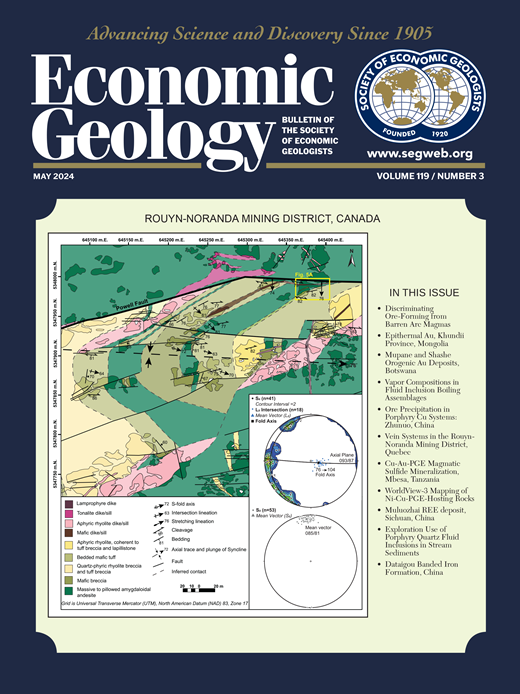最近在美国缅因州北部发现的一种以粗叶岩为主的稀土元素铌锆矿床
IF 5.5
1区 地球科学
Q1 GEOCHEMISTRY & GEOPHYSICS
引用次数: 1
摘要
本文报道了美国缅因州北部彭宁顿山(Pennington Mountain)一处以前未知的含稀土元素(REE) nb - zr矿的地质、地球物理、矿物学和地球化学数据。该产层是通过区域性多参数航空辐射测量新发现的,该测量显示Th (eTh)和U (eU)当量异常高,并通过详细的地面辐射测量、便携式x射线荧光(pXRF)和代表性岩石样品的全岩分析得到证实。矿区位于侵入奥陶系火山岩的细长粗面体(~1.2 km2)内。地质条件限制表明粗面岩的年代也属于奥陶纪。粗面岩东叶(~900 × ~400 m)普遍角化,基质中含有主要由钾长石、钠长石、细粒锆石和独居石组成的缝、透镜和细脉。重晶石在当地很丰富。基质中的次要矿物包括柱长石、bastnäsite、永长石、绿泥石、黄铁矿、闪锌矿和磁铁矿。从东叶收集的22个样品(App. Table A1)的pXRF分析表明,粗叶的整个部分是高度矿化的。东叶样品的全岩地球化学分析显示,Zr (1.17 wt %)、Nb (1,656 ppm)、Ba (3,132 ppm)、Y (1,140 ppm)、Hf (324 ppm)、Ta (122 ppm)、Th (124 ppm)、U (36.5 ppm)、Zn (689 ppm)和Sn (106 ppm)的平均含量较高。轻稀土元素中La (763 ppm)和Ce (1479 ppm)的平均浓度最高。对于重REE (HREE), Dy和Er的平均含量最高(分别为167和114 ppm)。没有发现富含三元素的矿物,如xenotime;稀土元素主要存在于独居石和bastnäsite中,也存在于细粒锆石中。Th与Zr、Nb、Y、Ce、Yb和Sn之间存在很强的正相关(R2), R2为0.92 ~ 0.98,表明eTh的辐射测量数据是矿化岩石中这些金属浓度的有效代表。在澳大利亚东部和中国中部的南秦岭带也发现了像Pennington山这样的长叶岩型REE-Nb-Zr矿床。根据与这些矿床的比较,以及Pennington山区缺乏详细的地质填图,我们认为在缅因州北部的其他地方可能存在其他含有稀有金属的粗面岩,并且在阿巴拉契亚-加里东造山带更广泛地存在火山和次火山粗面岩。本文章由计算机程序翻译,如有差异,请以英文原文为准。
A RECENTLY DISCOVERED TRACHYTE-HOSTED RARE EARTH ELEMENT-NIOBIUM-ZIRCONIUM OCCURRENCE IN NORTHERN MAINE, USA
Reported here are geological, geophysical, mineralogical, and geochemical data on a previously unknown trachyte-hosted rare earth element (REE)-Nb-Zr occurrence at Pennington Mountain in northern Maine, USA. This occurrence was newly discovered by a regional multiparameter, airborne radiometric survey that revealed anomalously high equivalent Th (eTh) and U (eU), confirmed by a detailed ground radiometric survey and by portable X-Ray fluorescence (pXRF) and whole-rock analyses of representative rock samples. The mineralized area occurs within an elongate trachyte body (~1.2 km2) that intrudes Ordovician volcanic rocks. Geologic constraints suggest that the trachyte is also Ordovician in age. The eastern lobe (~900 × ~400 m) of the trachyte is pervasively brecciated with a matrix containing seams, lenses, and veinlets composed mainly of potassium feldspar, albite, and fine-grained zircon and monazite. Barite is locally abundant. Minor minerals within the matrix include columbite, bastnäsite, euxenite, chlorite, pyrite, sphalerite, and magnetite. The pXRF analyses of 22 samples (App. Table A1) collected from the eastern lobe demonstrate that this entire part of the trachyte is highly mineralized. Whole-rock geochemical analyses for samples from the eastern lobe document high average contents of Zr (1.17 wt %), Nb (1,656 ppm), Ba (3,132 ppm), Y (1,140 ppm), Hf (324 ppm), Ta (122 ppm), Th (124 ppm), U (36.5 ppm), Zn (689 ppm), and Sn (106 ppm). Among light REE, the highest average concentrations are shown by La (763 ppm) and Ce (1,479 ppm). For heavy REE (HREE), Dy and Er are the most abundant on average (167 and 114 ppm, respectively). No HREE-rich minerals such as xenotime have been identified; the HREE may reside chiefly in monazite and bastnäsite, and within the fine-grained zircon. Very strong positive correlations (R2) of 0.92 to 0.98 exist between Th and Zr, Nb, Y, Ce, Yb, and Sn, indicating that the radiometric data for eTh are valid proxies for concentrations of these metals in the mineralized rocks.
Trachyte-hosted REE-Nb-Zr deposits like the occurrence at Pennington Mountain also are known in eastern Australia and in the south Qinling belt of Central China. Based on comparisons with these deposits, and the lack of detailed geologic mapping in the Pennington Mountain region, we suggest that other rare-metal occurrences contained in trachyte may exist elsewhere in northern Maine, and more widely in the Appalachian-Caledonian orogen where volcanic and subvolcanic trachytes have been recognized.
求助全文
通过发布文献求助,成功后即可免费获取论文全文。
去求助
来源期刊

Economic Geology
地学-地球化学与地球物理
CiteScore
10.00
自引率
6.90%
发文量
120
审稿时长
6 months
期刊介绍:
The journal, now published semi-quarterly, was first published in 1905 by the Economic Geology Publishing Company (PUBCO), a not-for-profit company established for the purpose of publishing a periodical devoted to economic geology. On the founding of SEG in 1920, a cooperative arrangement between PUBCO and SEG made the journal the official organ of the Society, and PUBCO agreed to carry the Society''s name on the front cover under the heading "Bulletin of the Society of Economic Geologists". PUBCO and SEG continued to operate as cooperating but separate entities until 2001, when the Board of Directors of PUBCO and the Council of SEG, by unanimous consent, approved a formal agreement of merger. The former activities of the PUBCO Board of Directors are now carried out by a Publications Board, a new self-governing unit within SEG.
 求助内容:
求助内容: 应助结果提醒方式:
应助结果提醒方式:


